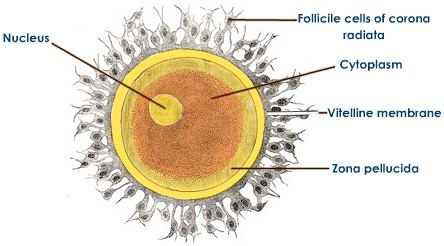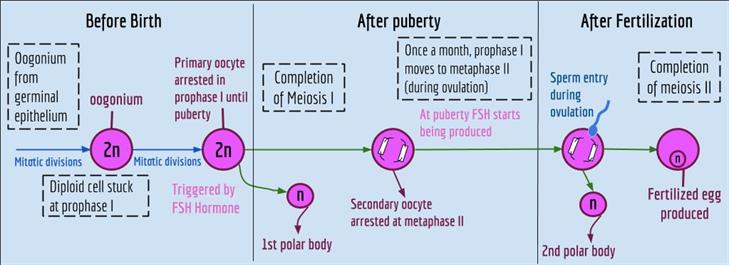
PUMPA - SMART LEARNING
எங்கள் ஆசிரியர்களுடன் 1-ஆன்-1 ஆலோசனை நேரத்தைப் பெறுங்கள். டாப்பர் ஆவதற்கு நாங்கள் பயிற்சி அளிப்போம்
Book Free DemoOvum is the female gamete that is produced in the ovaries of the female.
The process of formation of a mature ovum in the ovaries is known as oogenesis.
The mature ovum or an egg is spherical in shape. The ovum is essentially yolk-free. It has abundant cytoplasm called ooplasm and a large nucleus. The nucleus contains a prominent nucleolus.
The plasma membrane surrounds the cytoplasm. Small vesicles called cortical granules are found under the plasma membrane. The ovum is surrounded by three membranes, namely:
1. Zona pellucida
2. Corona radiata
3. Vitelline membrane

Structure of the ovum
The plasma membrane is surrounded by an inner thin zona pellucida and an outer thick corona radiata. Zona pellucida is acellular. The corona radiata is formed of the follicular cells. The membrane forming the surface layer of the ovum is called the vitelline membrane. The fluid-filled space between the zona pellucida and the surface of the egg is called perivitelline space.
The video showing the structure of the ovum:
In contrast to males, in females, the initial steps occur prior to their birth. Diploidoogonia and primary oocytes are produced in the foetus when she is born.
In oocytes, the first meiotic division is initiated and then stopped. No further development occurs until the girl becomes sexually mature. After maturity, the primary oocytes resume their development. The primary oocytes grow further and complete meiosis I, forming a large secondary oocyte and a small polar body.
Only after fertilization, meiosis II is completed. By the completion of meiosis II, secondary oocytes get converted into a fertilized egg or zygote.

Process of oogenesis
Puberty:
When the reproductive system in both males and females becomes functional, there is an increase in sex hormone production, resulting in puberty. This phenomenon starts earlier in females than in males. Generally, boys attain puberty between the age of \(13\) to \(14\) \(years\). The girls reach puberty between \(11\) to \(13\) \(years\).
In a male, the onset of puberty is triggered by the secretion of the hormone testosterone in the testes. While in females, the secretion of estrogen and progesterone from the ovary triggers puberty.
As we have seen in an earlier chapter, the secretion of male and female hormones are under the control of the pituitary gonadotropins luteinizing hormone (LH) and follicle-stimulating hormone (FSH).
During puberty, the individuals of the two sexes show distinctive features called secondary sexual characteristics. Some of the male secondary sexual characteristics are facial hair, cracking of voice, etc.
Female secondary sexual characteristics include development of breasts, broadening of hips, etc. Such distinguishing features are present in all the animals. These characteristics serve to identify and attract sex partners.
Reference:
https://humanreproduction11.wordpress.com/fertilization/
https://upload.wikimedia.org/wikipedia/commons/c/cc/Biology_Wiki_Diagram_--_oogensis.jpg